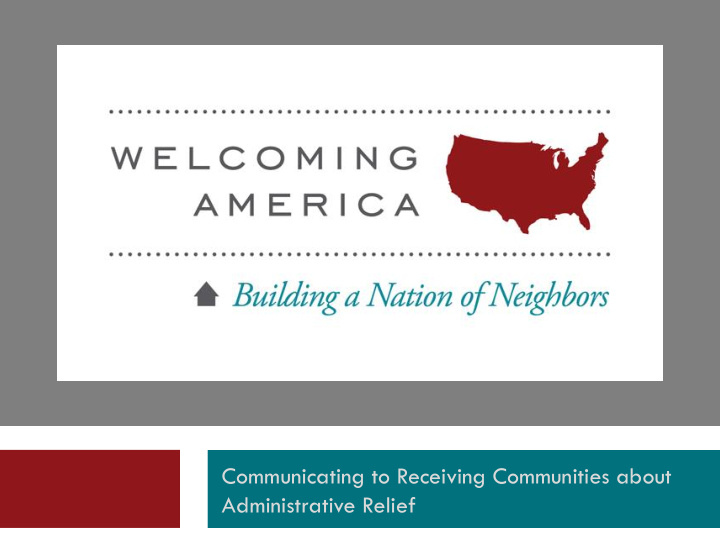



Communicating to Receiving Communities about Administrative Relief
Today’s Agenda Welcome and Introduction Jessy Molina and David Lubell, Welcoming America Immigration Law Overview – Kari Hong Kari Hong, Boston College Law School Q&As Tips for Effective and Positive Messaging on Administrative Relief Rachel Peric, Welcoming America and Amanda Cooper, Lighbox Collaborative Q&As
Immigration Law Overview Prof. Kari Hong Boston College Law School
When can someone receive permission to stay in the United States? Family ties Asylum (life is in danger in native country) Employment
When does someone no longer have permission to be in the United States? No longer have permission to stay in existing status ◦ E.g., tourist visa expires after 3 to 6 months ◦ Fails to apply to have conditions removed from green card (if based on marriage) ◦ Does not file the proper paperwork in time (family and employment) Immigration violations ◦ Remaining without status ◦ Criminal acts ◦ Criminal convictions
What the old law used to be: Before 1997, immigration law had a balance between eligibility requirements and discretion ◦ People could legalize if without status ◦ Could receive green cards after 7 years if established strong familial or community ties ◦ Could apply for waivers and pay fines to forgive immigration violations if had family or employment tie to remain
What caused the current immigration crisis? In 1997, Congress passed the Ilegal Immigration Reform and Immigrant Responsibility Act (IIRIRA) ◦ Ended discretion ◦ Ended waivers and fines ◦ Ended ways to legalize status ◦ Broadened crimes that could serve as basis for removal (deportation) ◦ Place strict time limits on applying for remedies (e.g., asylum)
What does the President Obama’s Executive Action help address? Pathway for parents of citizen children and lawful permanent resident children to receive temporary status Expands DACA Eases processing of high-tech, skilled labor jobs Attempts to change how non-citizens with criminal convictions are identified
What does the Executive Action not address? Non-citizens who do not have children Continues to remove/deport those with criminal convictions Does not apply to people who entered the country after January 1, 2014 Will probably not benefit people who have convictions ◦ May include minor convictions such as DUIs
Information non-citizens need Find reliable sources of information about the new programs ◦ Details and forms will not be released until 2015 If they have had any contact with law enforcement, meet with an immigration lawyer Meet with credible attorneys and non- profit organizations ◦ Avoid scams and notarios
Resources Finding facts, forms, and updates: ◦ http://www.dhs.gov/immigration-action Finding a starting place to find an attorney ◦ http://www.ailalawyer.com Economic and political benefits of executive action ◦ http://www.whitehouse.gov/the-press- office/2014/11/21/fact-sheet-economic- benefits-fixing-our-broken-immigration-system
Tips for Effective and Positive Messaging on Administrative Relief Rachel Peric, Welcoming America Amanda Cooper, Lightbox Collaborative
Nashville
Audience: Receiving Communities Photo credit: Welcoming Framingham
Good Messaging
From Policy to People Credit: Welcoming Long Island and Immigrant Nation
Good for communities Credit: Uniting NC
Define America
Prosperous Communities
New Americans who have been in the US for at least five years will add $6 billion more in payroll taxes in the first year of the program, and over $45 billion over five years.
Tough Questions
How do we get these stories out?
Recommend
More recommend